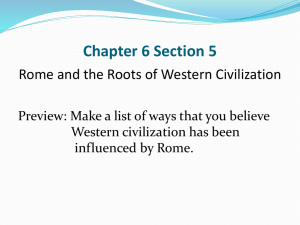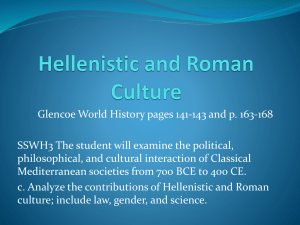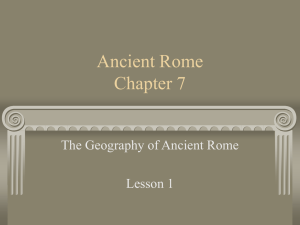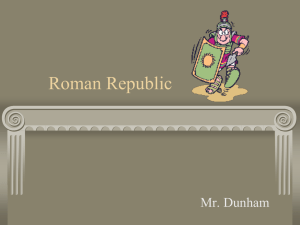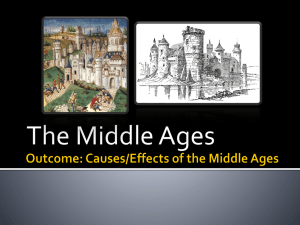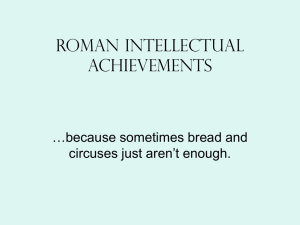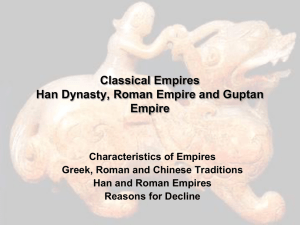Chapter 5: An Age of Empires: Rome and Han China, 753 B.C.E.
advertisement
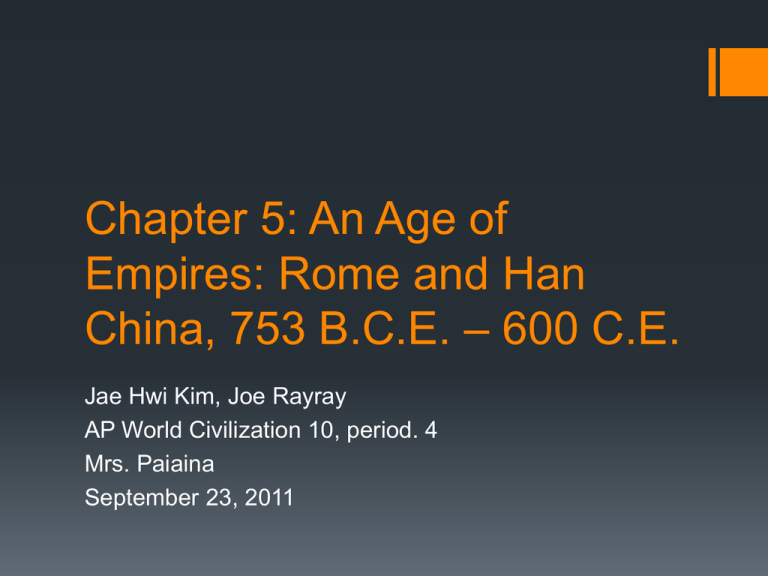
Chapter 5: An Age of Empires: Rome and Han China, 753 B.C.E. – 600 C.E. Jae Hwi Kim, Joe Rayray AP World Civilization 10, period. 4 Mrs. Paiaina September 23, 2011 Roman empire’s geography Roman empire encompassed all the lands surrounding the Mediterranean sea as well as portions of continental Europe and the Middle East. Republic Rome’s Republic lasted from 507 to 31 B.C.E., which Senates played a dominant role in the politics of the Roma state. Class and Social Relations Roman women did not have much power, but they were less constrained than their Greek counterparts and over time they gained greater freedom and power. The basic unit of Roman society was the family In Rome, complex ties of obligation such as patron/client relationship bounded together individuals of different classes. Roman religion Romans equated their deities with Greek gods, such as Jupiter with Greek Zeus, and Mars with Greek Ares. Expansion of Rome Rome expanded slowly at first, but later gained momentum and reached a peak in the second centuries B.C.E. The Failure of the Republic and Civil Wars Between 88 and 31 B.C.E., a series of ambitious individuals – Sulla, Pompey, Julius Caesar, Mark Antony, and Octavian – commanded armies more loyal to them than to the states and led bloody civil wars. Chronology Octavian Julius Caesar’s grandnephew and heir, Octavian, also known as Augustus, changed the Roman system of government. Octavian eliminated all rivals and made many allies with equites, the class of well-to-do Italian merchants and landowners. Life in the Cities and Countryside The upper classes of Rome lived in elegant townhouses on hills and houses were centered around atrium, a rectangular courtyard with an open skylight that let in light and rainwater. The wealth was concentrated in the cities but was based on the productivity of rural laborers. Commerce Roman commerce was greatly enhanced by the pax romana, which guaranteed the safety and stability of trade. Romanization There was Romanization which is the spread of the Latin language and Roman way of life which influenced many other languages of Europe and others. The Rise of Christianity Jesus, the central figure of Christianity, sought to reform Jewish beliefs and practices, and he was executed as a revolutionary by the Romans. Paul established churches and preached the new religion. Christians were first persecuted by Roman officials, but the church continued to grow and expand. Technology and Transformation Romans built Aqueducts, which brought water from a source to an urban center using force of gravity. The Roman army was reorganized and redeployed to reflect the shift from an offensive to a defensive strategy. Third-Century Crisis and its restore From 235 to 284 C.E., there were political, military, and economic problems which nearly destroyed the Roman empire. Diocletian implemented radical reforms that saved the Roman state by transforming it. Constantine became ruler after Diocletian resigned in 305, and Constantine made Christianity a favored religion after reuniting the Roman Empire. Qin unification of China Qin defeated its rivals and became the ultimate winner, and Zheng became the emperor at the age of thirteen with the title of Shi Huangdi. Shi Huangdi attacked nomads, but it had huge consequence which posed huge military threat. After the fall of the Qin, Shi Huangdi was buried with a great bond of earth. Gaozu Even after the overthrow of the Qin, fighting continued. The dynasty of Han was inaugurated, and Gaozu, the new emperor, courted popularity and consolidated their rule by denouncing Qin and Qin’s laws. Wu After Gaozu’s death, We became the successor of the throne and he increased the owner of the emperor. Sima Qian composed a monumental history of China. He is also called “the father of history”. Chinese Society Woman’s status depended on her “location” within various social institutions, women could be influential political figure if the women are from royal family. The fundamental unit was the family, and within the family was a clear-cut hierarchy headed by the oldest male. Chang’an Chang’an was the city in the Wei Valley in eastern China which became the capital of the Qin and early Ham Empires. Chang’an was imitated in the cities and towns. New Forms of Thought and Belief There were inventions and new thoughts of watermill, horse collar, paper, seismometer, and large scale roads. Decline of the Han When Wang Mang seized the power in 9-23 C.E., he implemented major reforms to address serious economic problems and to cement his popularity with the common people, but flood and uprising caused imperial court to be plagued by weak leadership and court intrigue. Many other factors support the fall of the Han, such as continuous military vigilance, increased power of aristocracy, and civil wars. End



